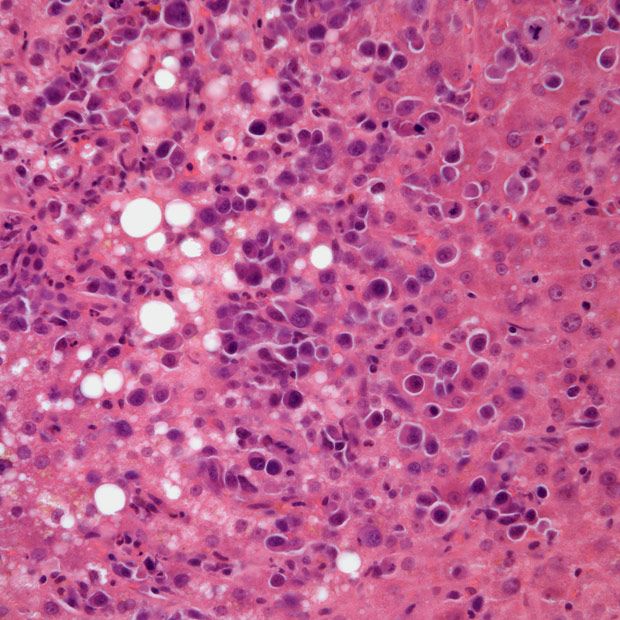D-VRd Prolongs PFS and Improves Depth of Response in Multiple Myeloma
Data from the phase 3 PERSEUS trial supports D-VRd followed by DR maintenance as a new standard of care in patients with newly diagnosed, transplant-eligible multiple myeloma.
Despite improved outcomes with novel treatments, the lack of curative therapy for patients with multiple myeloma continues to result in high mortality rates. The SOC for younger patients is VRd followed by ASCT, VRd consolidation, and lenalidomide maintenance.

Induction therapy consisting of daratumumab (Darzalex) plus autologous stem cell transplant (ASCT), bortezomib (Velcade), lenalidomide (Revlimid), and dexamethasone (D-VRd), followed by daratumumab/lenalidomide (DR) maintenance significantly improved progression-free survival (PFS) compared with VRd induction followed by lenalidomide maintenance in those with newly diagnosed, transplant-eligible multiple myeloma, according to primary findings from the phase 3 PERSEUS trial (NCT03710603) presented during the 2023 American Society of Hematology (ASH) Annual Meeting and Exposition.1
At a median follow-up of 47.5 months, the 4-year progression-free survival (PFS) rate with D-VRd was 84.3% vs 67.7% with VRd, resulting in a 58% reduction in the risk of disease progression or death with the addition of the CD38 monoclonal antibody (HR, 0.42; 95% CI, 0.30-0.59; P <.0001).
Additionally, the overall rate of complete response or better (≥CR) was 87.9% with D-VRd vs 70.1% with VRd (P <.0001). The rates of stringent CR (sCR) and CR were 69.3% and 18.6%, respectively, with D-VRd vs 44.6% and 25.4% with VRd. Notably, D-VRd led to improved ≥CR rates regardless of sex, age, race, International Staging System stage, type of multiple myeloma, cytogenetic risk, or ECOG performance status.
D-VRd also led to higher rates of minimal residual disease (MRD) negativity at a sensitivity of 10-5 (75.2% vs 47.5% for D-VRd vs VRd; OR, 3.40; 95% CI, 2.47-4.69; P <.0001) and 10-6 (65.1% vs 32.2%; OR, 3.97; 95% CI, 2.90-5.43; P <.0001). Sustained MRD negativity at a sensitivity of 10-5 for at least 12 months was also more than doubled in the D-VRd arm, at 64.8% vs 29.7% in the VRd arm.
“These randomized, phase 3 results support D-VRd followed by DR maintenance as a new standard of care [SOC] for transplant-eligible patients with newly diagnosed multiple myeloma,” lead study author Pieter Sonneveld, MD, of the Erasmus MC Cancer Institute in Rotterdam, Netherlands, said in a presentation of the data. “[Additionally], 64% of patients receiving maintenance in the D-VRd group were able to discontinue daratumumab after achieving sustained MRD negativity per protocol.”
Despite improved outcomes with novel treatments, the lack of curative therapy for patients with multiple myeloma continues to result in high mortality rates. The SOC for younger patients is VRd followed by ASCT, VRd consolidation, and lenalidomide maintenance. Previously, findings from the phase 2 GRIFFIN trial (NCT02874742) showed that the addition of daratumumab to VRd led to improved PFS in patients with transplant-eligible, newly diagnosed multiple myeloma.2
To be eligible for enrollment to PERSEUS, patients had to be between the ages of 18 and 70 years and have newly diagnosed, transplant-eligible multiple myeloma and an ECOG performance status of 2 or less. A total of 709 patients were randomly assigned to the investigational or control arms, both of which included induction, consolidation, and maintenance phases.
In the control arm, patients received 1.3 mg/m2 of subcutaneous bortezomib on days 1, 4, 8, and 11; plus 25 mg of oral lenalidomide on days 1 through 21; and 40 mg of oral or intravenous dexamethasone on days 1 through 4 and 9 through 12 as induction prior to transplant. Afterward, patients received the same schedule of VRd, followed by 10 mg of oral lenalidomide on days 1 through 28 until disease progression. In the investigational arm, patients received 1800 mg of subcutaneous daratumumab every 2 weeks plus the same schedule of VRd as induction treatment. After undergoing transplant, patients received D-VRd as consolidation, followed by daratumumab at 1800 mg every 4 weeks plus lenalidomide at 10 mg on days 1 through 28.
In the investigational arm, if patients were MRD positive after maintenance they continued to received DR until disease progression. If patients were MRD negative in a ≥CR for at least 12 months following at least 24 months of maintenance therapy, they could discontinue daratumumab. Daratumumab was restarted if the disease fell out of CR without evidence of disease progression or MRD recurrence.
The primary end point of the study was PFS. Secondary end points included the overall ≥CR rate, overall MRD-negativity rate, and overall survival.
“The observed safety profile was consistent with the known safety profiles for subcutaneous daratumumab and VRd,” the authors concluded.
References
- Sonneveld P, Dimopoulos MA, Boccadoro M, et al. Phase 3 randomized study of daratumumab + bortezomib, lenalidomide, and dexamethasone (VRd) versus VRd alone in patients with newly diagnosed multiple myeloma who are eligible for autologous stem cell transplantation: primary results of the PERSEUS trial. Blood. 2023;142(suppl 2):LBA1. doi:10.1182/blood-2023.191911
- Sborov DW, Laubach J, Kaufman JL, et al. Daratumumab (dara) + lenalidomide, bortezomib, and dexamethasone (RVd) in patients with transplant-eligible newly diagnosed multiple myeloma (NDMM): final analysis of GRIFFIN. Presented at: 19th International Myeloma Society Annual Meeting; August 25-27, 2022; Los Angeles, CA. Abstract OAB-057